Author: Charles Yu, Galaxy; Compiler: Tao Zhu, Golden Finance
Summary
Bitcoin ETFs received $15.1 billion in net inflows between launch (Jan 11, 2024) and Jun 15, 2024.
Nine issuers are vying to launch 10 Ethereum spot ETFs in the U.S.
After approving all 19b-4 filings on May 23, the SEC expects to allow these instruments to trade effective in July 2024.
As with Bitcoin ETFs, we believe the primary new net entrants are independent investment advisors, or investment advisors affiliated with banks or broker/dealers.
We expect ETH ETF net inflows to account for 20-50% of BTC ETF net inflows in the first 5 months, with our target being 30%, which would imply $1 billion in net inflows per month.
Overall, we believe ETHUSD is more price sensitive to ETF inflows than BTC, as a large portion of ETH’s total supply is locked in staking, bridges, and smart contracts, while supply on centralized exchanges is lower.
Foreword
For months, observers and analysts have downplayed the likelihood of the U.S. Securities and Exchange Commission (SEC) approving a spot-based Ethereum exchange-traded product (ETP). This pessimism stems from the SEC’s reluctance to explicitly state that Ethereum is a commodity, reports of no engagement between the SEC and potential issues, and news of the SEC’s investigation and pending enforcement actions into the Ethereum ecosystem. Bloomberg analysts Eric Balchunas and James Seyffart had given a 25% chance of approval in May. However, on Monday, May 20, Bloomberg analysts suddenly raised the odds of approval to 75% following reports that the SEC had contacted the stock exchanges. In fact, all Ethereum spot ETP applications received SEC approval later that week. As we await the actual launch of these instruments after the S-1 filings become effective (which we expect to occur sometime in the summer of 2024), this report takes cues from the performance of Bitcoin spot ETPs to forecast demand for Ethereum ETPs. We estimate that spot Ethereum ETPs will see net inflows of approximately $5 billion (approximately 30% of Bitcoin ETP net inflows) in their first five months of trading.
Background
There are currently nine companies competing to launch 10 exchange-traded products (ETPs) that hold spot ETH. In the past few weeks, some issues have been resolved. ARK chose not to work with 21Shares on an Ethereum ETP, while Valkyrie, Hashdex, and WisdomTree have withdrawn their applications entirely. The chart below shows the current status of applicants sorted by 19b-4 filing date:
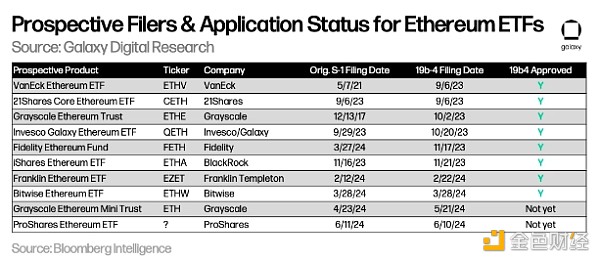 Grayscale is looking to convert the Grayscale Ethereum Trust (ETHE) into an ETP, just as the company did with its Grayscale Bitcoin Investment Trust (GBTC), but has also applied for a “mini” version of the product.
Grayscale is looking to convert the Grayscale Ethereum Trust (ETHE) into an ETP, just as the company did with its Grayscale Bitcoin Investment Trust (GBTC), but has also applied for a “mini” version of the product.
The U.S. Securities and Exchange Commission (SEC) approved all 19b-4s (the rule change that allows stock exchanges to list final spot ETH ETPs) on May 23, but now each issuer will need to go back and forth with the regulator on their registration statements. Until the SEC allows these S-1s (or S-3s in the case of ETHE) to become effective, the products themselves can’t actually begin trading. Based on our research, as well as reporting from Bloomberg Intelligence, we believe Ethereum spot ETPs could begin trading as early as the week of July 11, 2024.
Lessons from BTC ETFs
Bitcoin ETFs have been live for approximately less than 6 months and can serve as a useful basis for examining the possible acceptance of an Ethereum spot ETF.
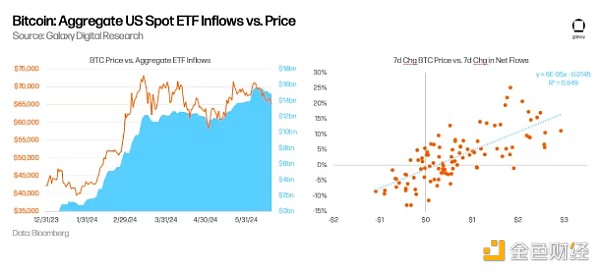
Some observations from the first few months of Bitcoin spot ETP trading are as follows:
So far, inflows have unexpectedly risen. As of June 15, U.S. spot Bitcoin ETFs have accumulated more than $15 billion in net inflows since their launch, with an average net inflow of $136 million per trading day. The total amount of BTC held by these ETFs is about 870,000 BTC, accounting for 4.4% of the current BTC supply. BTC is trading at about $66,000, and the total assets under management of all US spot ETFs are about $58 billion (Note: GBTC held about 619,000 BTC before the launch of the ETF). ETF inflows are partly responsible for the rise in BTC prices. Regressing the 1-week change in BTC 5-month price and 1-week ETF net flows, we calculate an r-sq of 0.55, indicating that the two variables are highly correlated. Similarly, we also find that price changes are a better leading indicator of flows, and vice versa.
Unwinding of GBTC trades has been a prominent issue for overall ETF flows. GBTC has experienced significant outflows in the first few months since the conversion of the trust to an ETF. Daily GBTC outflows peaked in mid-March, with $642 million in outflows on March 18, 2024. Outflows have slowed since then, with GBTC even seeing several consecutive days of positive net inflows starting in May (there were 78 days of outflows before the first day of net inflows on May 3). As of June 15, the BTC balance held in GBTC has declined since the ETF launch, from 619k BTC to 278k BTC (-55%).
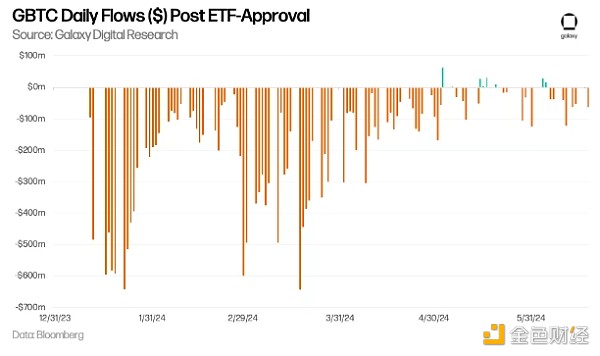
ETF demand is mainly driven by retail investors; institutional demand picks up. 13F filings show that as of March 31, 2024, more than 900 U.S. investment companies held Bitcoin ETFs, holding approximately $11 billion worth of assets, or about 20% of total Bitcoin ETF holdings, indicating that most of the demand is driven by retail investors. The list of institutional buyers includes well-known banks (e.g., JPMorgan Chase, Morgan Stanley, Wells Fargo), hedge funds (e.g., Millennium, Point72, Citadel), and even pension funds (e.g., Wisconsin Investment Board).
Wealth management platforms have yet to add access to Bitcoin ETFs. The largest wealth platforms have yet to allow their brokers to recommend Bitcoin ETFs, although Morgan Stanley is reportedly exploring facilitating its brokers to solicit client purchases. Bitcoin ETF access across wealth platforms (including broker-dealers, banks, and RIAs) could take years. The release of sales-driven inflows from institutional platform access has been small so far, but we believe it will be a significant catalyst for Bitcoin adoption in the short to medium term.
Estimating Potential ETH ETF Inflows
Using Bitcoin ETPs as a proxy, we can estimate potential demand for similar Ethereum products.
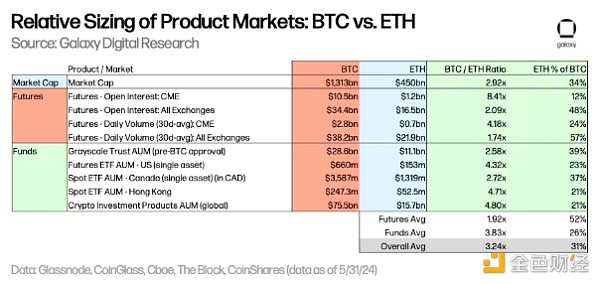
To estimate potential inflows into an ETH ETF, we apply a BTC/ETH multiple to Bitcoin US spot ETF inflows based on the relative asset sizes of multiple markets where BTC and ETH trade. As of May 31:
BTC’s market cap is 2.9 times that of ETH.
Across all exchanges, the BTC futures market is roughly 2x larger than ETH based on open interest levels and trading volume. For CME in particular, BTC’s open interest level is 8.4x that of ETH, while BTC’s daily trading volume is 4.2x that of ETH.
Audience under management of various existing funds (by Grayscale Trust, by product (e.g., futures, spot), and selected global markets) shows that BTC funds are roughly 2.6x to 5.3x larger than ETH funds.
Based on the above, we believe Ethereum spot ETF inflows will be about 3x less than U.S. spot Bitcoin ETF inflows (consistent with the upper multiple), ranging from 2x to 5x. In other words, we think Ethereum spot ETF inflows could be 33% of US spot Bitcoin ETF inflows, with inflows in USD terms ranging from ~20% to 50%. Applying this multiple to the $15 billion in Bitcoin spot ETF inflows as of June 15th, implies ~$1 billion in monthly ETH ETF inflows in the first five months following Ethereum ETF approval and launch (estimated range: $600 million to $1.5 billion per month).
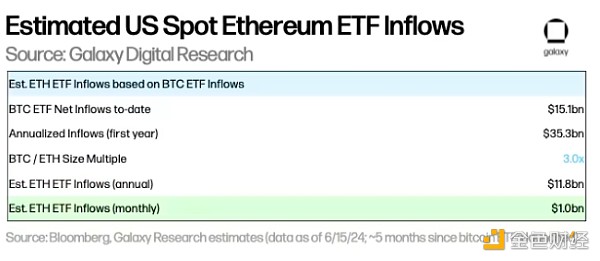
We find some estimates lower than our forecasts due to several factors described below. That is, our previous report's forecast of $14 billion in first-year Bitcoin ETF inflows was based on the entry of wealth management platforms, but Bitcoin ETFs saw significant inflows before these platforms arrived. Therefore, we recommend caution in predicting low demand for Ethereum ETFs.
Several structural/market differences between BTC and ETH will affect ETF flows:
Demand for spot Ethereum ETFs may be limited due to the lack of staking rewards. The opportunity cost of unstaked ETH includes: (i) inflation rewards paid to validators (which also have a negative dilution effect), (ii) priority fees paid to validators, and MEV income paid to validators via relayers. Using consolidated data (>9/15/22) through 6/15/24, we estimate that the annualized opportunity cost of including staking rewards for spot ETH holders is 5.6ppt (or 4.4ppt using YTD data), a non-significant difference. This would make a spot ETH ETF less attractive to potential buyers. Note that ETPs offered elsewhere outside the U.S. (e.g., Canada) offer holders additional yield via staking.

Grayscale's ETHE may drag down the inflow of Ethereum ETF. Just as the GBTC Grayscale Trust Fund saw a large outflow of funds during the ETF conversion process, the conversion of the ETHE Grayscale Trust Fund to an ETF will also lead to outflows. Assuming that the rate of ETHE outflows in the first 150 days is consistent with the rate of GBTC outflows (i.e., 54.2% of the trust supply is withdrawn), we estimate that the monthly outflow of ETHE is approximately 319,000 ETH, which is $1.1 billion or an average daily outflow of $36 million at the current price of ~$3,400. Note that the percentage of supply held by these trusts is 3.2% of BTC supply and 2.4% of ETH supply, which suggests that the drag on ETH price from ETHE ETF conversions is relatively small relative to GBTC conversions. In addition, unlike GBTC, ETHE will not face forced sellers due to bankruptcy (such as 3AC or Genesis), which would further support the view that ETH has relatively less selling pressure associated with the Grayscale Trust compared to BTC. Basis trading may have driven the demand for Bitcoin ETFs from hedge funds. Basis trading may have driven the adoption of ETFs by hedge funds that want to arbitrage the difference between Bitcoin spot and futures prices. As mentioned earlier, 13F filings show that as of March 31, 2024, more than 900 U.S. investment companies held Bitcoin ETFs, including some well-known hedge funds such as Millennium and Schonfeld. Throughout 2024, ETH's average funding rate across exchanges is higher than BTC's, suggesting that (i) demand to be long ETH is relatively large and (ii) a spot ETH ETF may attract greater demand from hedge funds that appear to be entering basis trades.
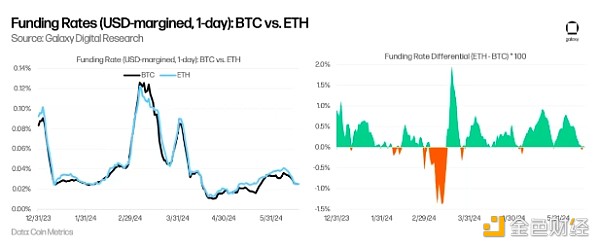
Factors Affecting ETH vs. BTC Price Sensitivity
Since our Ethereum ETF inflow estimate is roughly equal to BTC inflow relative to market cap, we expect the price impact to be roughly the same, all else being equal. However, there are several key differences in supply and demand between the two assets that could make Ethereum more price sensitive to ETF flows: Supply held on exchanges: Currently, exchanges hold a higher percentage of BTC supply than ETH supply (11.7% vs. 10.3%), suggesting that ETH is more price sensitive to ETF flows. Supply is likely to be tighter, and assuming proportional levels, ETH price will be more sensitive to inflows relative to market cap (note: this metric relies heavily on exchange address attribution and varies widely across data providers).
Inflation & Burns: Following the most recent halving on April 20, 2024, BTC has an annual inflation rate of ~0.8%. Post-merger (September 15, 2022), Ethereum net issuance is negative (-0.19% per year) as new issuance paid to stakers (+0.63%) has been offset by base fees burned (-0.83%). In the most recent month, ETH base fees were relatively low (-0.34% annualized) and have failed to offset new issuance (+0.76% annualized), resulting in an annualized net inflation rate of +0.42%.
Supply Held in ETF:Net BTC entering the US spot ETF since launch (excluding GBTC starting balance) totals 251,000 BTC, or 1.3% of current supply. If annualized, the ETF would absorb 583,000 BTC, or 3.0% of BTC's current supply, which would far exceed the dilution of miner rewards (inflation is 0.81%).
However, the actual market liquidity available to purchase the ETF is far less than the reported current supply. We believe that a better representation of the available market supply for each asset in the ETF would include adjustments for factors such as staked supply, dormant/lost supply, and supply held in bridges and smart contracts:
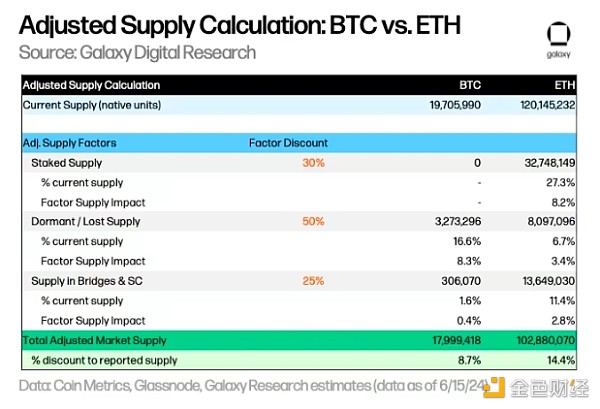
Staked Supply (Discount: 30%):Staked supply reduces the amount of liquidity the ETF can absorb. Currently, there is no option to stake BTC. Staking ETH is required to secure the network, but stakers can use part of their ETH stake elsewhere. Currently, the amount of ETH staked is ~27% of ETH’s current supply, and we apply a 30% discount to estimate the available market supply, resulting in an 8.2% discount on factor supply.
Dormant/Lost Supply (Discount: 50%):Some BTC and ETH are assumed to be unrecoverable (e.g., lost keys, boating accidents), so this reduces the available supply; we use a 10+ year dormant supply for BTC and ETH supply held in addresses last active 7 years ago, which equates to 16.6% and 6.7% of BTC and ETH’s current supply, respectively. We apply a 50% discount rate to this balance, as the supply held in some of these supposed dormant addresses could come back online at any time.
Supply in Bridges and Smart Contracts (Discount: 25%):This is the supply locked in bridges and contracts for production reasons. For Bitcoin, the BTC balance in wrapped BTC (wBTC) custodial by BitGo is ~153k BTC, and we estimate roughly the same amount locked in other bridges, totaling ~1.6% of BTC supply. ETH locked in smart contracts is ~11.4% of current supply. We apply a lower 25% discount to this balance than to the staked supply, as we assume this supply is more liquid than the staked supply.
Applying the discount weights to each factor to calculate the adjusted supply for BTC and ETH, we estimate the available supply of BTC and ETH to be 8.7% and 14.4% less than their reported current supply, respectively.
Overall, ETH should have higher price sensitivity to relative capital-weighted inflows compared to BTC due to: (i) lower available market supply based on adjusted supply factors, (ii) lower percentage of exchange supply, and (iii) lower net emission. Each of these factors should have a multiplicative (rather than additive) effect on price sensitivity with the others, with prices tending to be more reflective of larger changes in market supply and liquidity.
Looking Ahead
Looking ahead, several questions confront us in terms of adoption and second-order effects:
How should PMs and allocators view BTC and ETH? Will existing holders migrate from a Bitcoin ETF to ETH? For allocators, some rebalancing is expected.
Will a spot Ethereum ETF attract new marginal buyers who haven't yet bought BTC? What will potential buyers look like who hold only BTC, only ETH, or a mix of both?
When will staking be added, if at all? Is staking reward unimportant for Ethereum spot ETF adoption? Given the lack of alternative investment products, will investment demand for DeFi, tokenization, NFTs, and other crypto-related applications drive greater adoption of Ethereum ETFs compared to Bitcoin?
What are the potential impacts on other alternatives? Are we more likely to see other alternative ETFs approved after Ethereum?
Overall, we believe the potential launch of a spot Ethereum ETF should have a significant positive impact on market adoption of Ethereum and the broader cryptocurrency market for two reasons: (i) expanded accessibility across all wealth sectors, and (ii) greater acceptance through formal recognition by regulators and trusted financial services brands. ETFs can expand the reach of retail and institutional investors, provide broader distribution through more investment channels, and can support the use of Ethereum in portfolios across more investment strategies. Additionally, greater awareness of Ethereum among financial professionals will ideally promote investment in and adoption of the technology.
Appendix: Accrued Value for Staking vs. Non-Staking ETH Holders
Generally speaking, changes in ETH supply come from new issuance (paid to validators) and base fees burned, which is more than enough to offset the inflationary impact of new issuance since the Shanghai upgrade (aka “the merge”) went live in September 2022, reducing ETH supply by 0.20% on a net basis.
If issuers were prohibited from staking ETH in an ETF, then the ETF would incur considerable opportunity costs in terms of lost validator revenue and dilution. Looking at staking validators from the perspective of unstaking ETH holders vs. non-staking, consider value accrual in various value streams:
The base fee portion of user transaction fees is burned, which reduces supply and benefits unstaking and staked ETH holders equally.
The priority fee portion of user transaction fees is revenue collected by validators (with no impact on non-staked ETH holders).
MEV payments are paid by searchers to builders and redistributed to validators via MEV Boost, which is similar to the priority fee, providing income to staked validators with no impact on non-staked ETH holders.
New issuance of block rewards has a dilutive effect on all ETH holders; however, for staked validators, new issuance acts as another source of income that is sufficient to offset the dilution effect of new issuance.
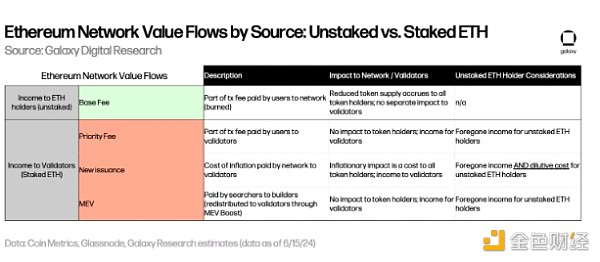
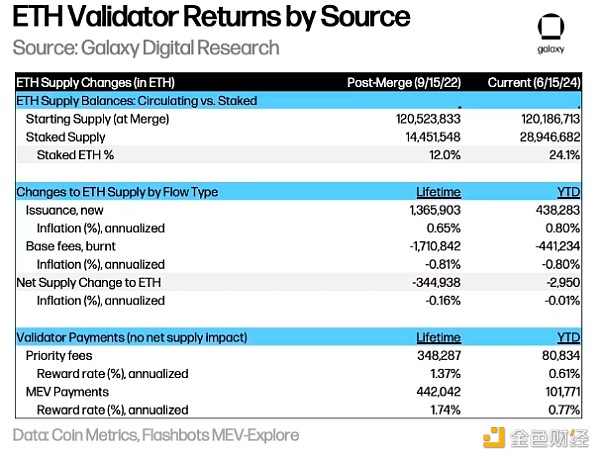
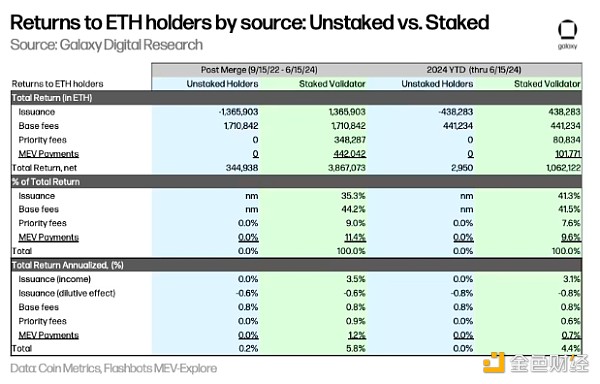
 Catherine
Catherine

 Grayscale is looking to convert the Grayscale Ethereum Trust (ETHE) into an ETP, just as the company did with its Grayscale Bitcoin Investment Trust (GBTC), but has also applied for a “mini” version of the product.
Grayscale is looking to convert the Grayscale Ethereum Trust (ETHE) into an ETP, just as the company did with its Grayscale Bitcoin Investment Trust (GBTC), but has also applied for a “mini” version of the product.











